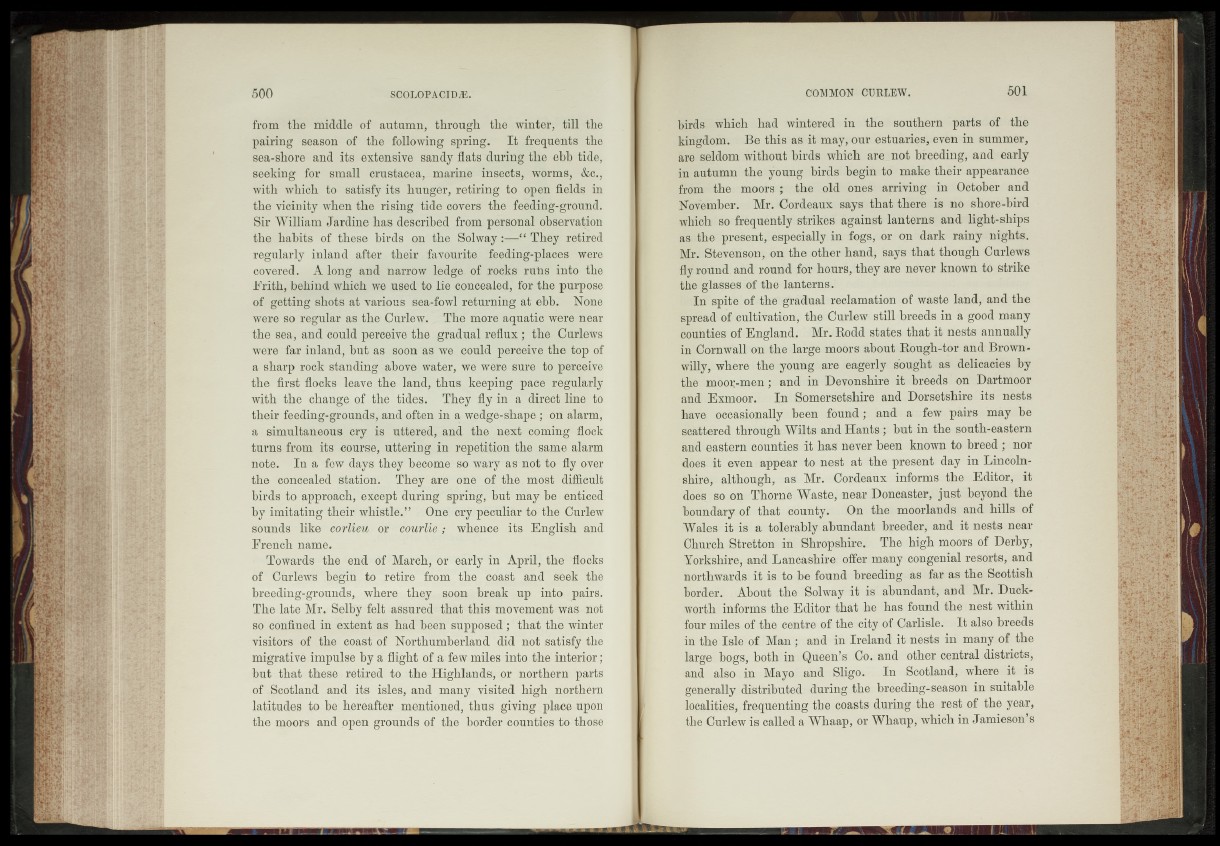
from the middle of autumn, through the winter, till the
pairing season of the following spring. Jt frequents the
sea-shore and its extensive sandy flats during the ebb tide,
seeking for small Crustacea, marine insects, worms-, - &c.,
with which to satisfy its hunger, retiring to open fields in
the vicinity when the rising tide* covers the feeding-ground.
Sir William Jardine has described from personal observation
the habits of these birds on the Solway :—“ They retired
regularly inland after their favourite feeding-places were
covered, A long and narrow ledge of .rocks runs into the
Frith, behind which we used to lie Concealed, for the purpose
of getting shots at various sea-fowl returning at ebb.l|i%f'one
were so regular as the Curlew. The more aquatic were near
the sea, and could perceive the gradual reflux ; the Curlews
were far inland, but as soon as we could perceive the top sof
a sharp rock standing- above water, we were sure' t-o perceive
the first flocks leave the land, thus keeping pace regularly
with the change of the tides. They fly in a direct line to
their feeding-grounds, and often in a wj|dge-shape ; on alarm,
a simultaneous cry is uttered,~and the .next coming flock
turns from its course, -atterin-gQin iepititiontt1be,.sa:me alarm
note. In a few days they" become vso wary as'not to fly over
the concealed station. They are one of the, most 'difficult
birds to approach, except during spring, but may be enticed
by imitating their whistleVj’ One' cry peculiar to the Curlew
sounds like éorlieùor * cpurlifr; whence its English and
French name.
■ i.Towards the end of March, or early in April, the' 'flocks
of Curlews begin to retire from the coast and" seek jthe
breeding-grounds, whe^e thgy^ .soon. bjeAt up into pairs.
The late Mr. Selby felt aSsuTedstbat thfe'movement Was not
so confined i?n extent as had been suppdslfl5;:that |hé^w®tér
visitors of the coast of ïforthumberland did n©if satisfy the
migrative impulse by a flight of a few miles into the interior;
but | that, these retired to the Highlands, or northern parts
of Scotland and its isles, and many visite^ high northern
latitudes to be hereafter mentioned, thus givings place-upon'
the moors and open grounds of the- border counties to those
birds which had wintered in the southern parts of the
kingdom. Be this as it may,;our estuaries, even in summer,
are seldom without birds which are_not breeding, and early
in autumn the young birds begin to make their appearance
from the moors ; the old ones arriving in October and
Hovember. Mr. Cordeaux says that there is no shore-bird
which so frequently strikes against lantern®* and light-ships
as the present, especially in fogs, or on dark rainy nights.
Mr. Stevenson, an the ether hand, says that though Curlews
fly.found.ahd round-for hours, they are never known to strike
the glasses of the lanterns.
In^spite of tlmgradual reclamation of waste land, and the
spread of cultivation, therLurlew still breeds in a good many
counties of England. Mr.’ Rodd states, that it -nests annually
inlrOornwall on,the large moors about Rough-tor and Brown*
willy, where the young are eagerly? sought as delicacies by
the moor-men; and in Devonshire it breeds on Dartmoor
and Exmoor. In Somersetshire and Dorsetshire its nests
have occasionally been found; and ai nfew pairs may be
scattered through Wilts and Hants ;■ but -in, .the south-eastern
and eastern counties it has never been known to breed; nor
does I t . even; appear to nest at the present day in Lincolnshire,
although, as Mr. Cordeaux informs the - Editor, it
does so .on, Thorne Waste, near Doncaster, just beyond the
boundary of that county. . On the moorlands and hills of
•Wales it is a tolerably abundant breeder, and it nests near
Church Stretton in Shropshire. The high moors of Derby,
Yorkshire, and Lancashire: ofler.many congenial resorts, and
.northwards it is torbe found breeding as far as the, Scottish
border.. About Ahe;-Solway it is abundant, and Mr. Duckworth
informs 1 the Editor that <he jbas found the nest within
four miles of .the. centre of the ‘city of Carlisle:jj, It also breeds
in-'the Isle ofcM&ii *; and in Ireland it nests in many of the
ijjrge- bogs,- both invQneeh’s Go. and- other central „districts^
and also „ini Mayo and Sligo. h-dkioScotlAndy where, it sis
generally distributed? during thebreeding-season in suitable
localities,-frequenting the coasts-during,the- rest of the year,
the Curlew is called a Whaap, or Whaup, which in JamiesoE&s